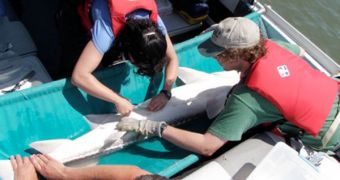After tagging thousands of marine creatures with acoustical transmitters, researchers are now prepared to start using the recently-develop Pacific Ocean Shelf Tracking (POST) network, which would enable them to eavesdrop on natural oceanic activity patterns.
For the past few years, about 16,000 animals have been tagged with acoustic emitters, which release signals that can be easily tracked using an array of powerful and very sensitive microphones.
Hundreds of miles of coastline have been wired with these receivers, which are capable of picking up the signals sent by the beacons attached on the target animals.
The journeys and migrations these creatures take through the ocean and rivers are about to be documented in minute detail, as each creature's signal is unique.
The POST network currently has an installed capacity of 400 microphones, all of which are located at strategic points alongside the West Coast of the United States.
Geographically, the microphones are spread from the shorelines to far out in the sea. The most forward ones are placed at the very end of the continental shelf.
The network extends for a whooping 1,800 miles (3,000 kilometers), from Alaska all the way to California. The data it collects can be downloaded wirelessly.
“People have very limited interactions with and understanding of animals under the water – it's a completely different environment, and we're limited in our ability to get down there and see what life is doing,” explains scientist Jonathan Thar.
“Technology like this really captures the imagination for me when it comes to what we might learn about a whole new world we don't know that much about,” adds the expert, who is a POST Project research program coordinator.
He adds that about 18 species of marine creatures have thus far been tagged using the acoustical devices. These animals include sharks, jumbo squid, salmon, and trout, OurAmazingPlanet reports.
“Sometimes tracking the animals brings surprising results that turn conventional wisdom upside down,” says the executive director of POST, Jim Bolger.
The most important findings made using the POST network are detailed online, in the August 31 issue of the open-access scientific journals PLoS ONE and PLoS Biology.

 14 DAY TRIAL //
14 DAY TRIAL //